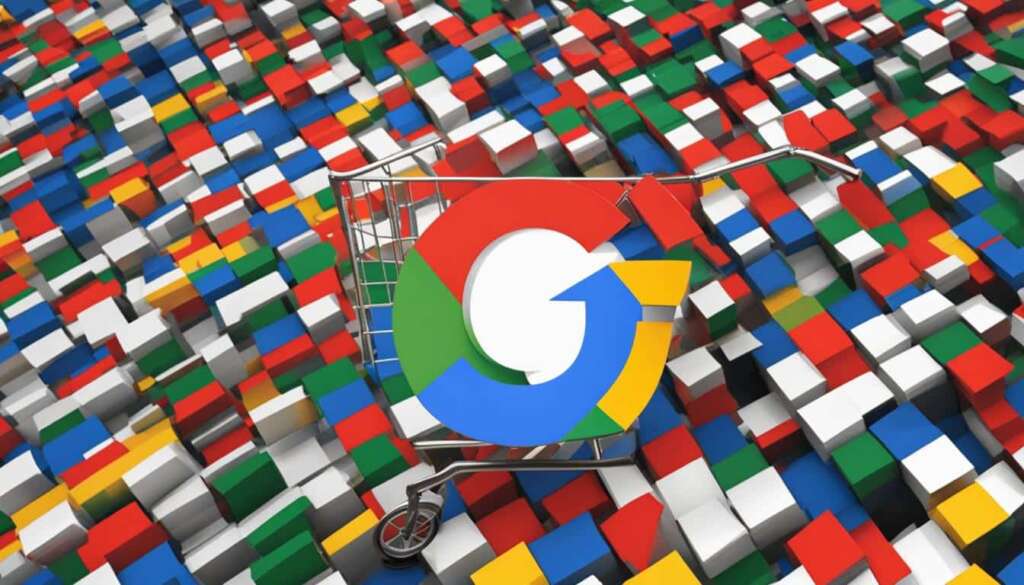Table of Contents
Welcome to our article on Google e-commerce strategies for successful sales. In this guide, we will explore ten proven strategies to help you grow your e-commerce business using Google. Whether you’re just starting or looking to boost your existing online store, these strategies will provide you with actionable insights to drive sales and increase profitability.
From segmenting your customers to leveraging PPC advertising, SEO, social media, email marketing, and more, we will cover a range of tactics designed to optimize your e-commerce performance on Google. These strategies have been tested and refined by industry experts and are proven to yield results.
So, if you’re ready to take your e-commerce business to the next level and achieve greater success, let’s dive into the world of Google e-commerce strategies. By implementing these techniques, you’ll be well on your way to attracting more customers, increasing sales, and boosting your online store’s profitability.
Segment Your Customers for Targeted Marketing
Marketing efforts cannot be one-size-fits-all. To effectively reach your target audience and maximize your marketing ROI, segmenting your customers is crucial. By dividing your customer base into subgroups based on shared characteristics such as demographics, psychographics, geography, and behavior, you can gain valuable insights into their needs and preferences.
Segmentation allows you to create more targeted marketing campaigns that resonate with specific customer segments, resulting in higher engagement and conversion rates. By understanding the unique challenges, desires, and pain points of each segment, you can tailor your messaging and offers to meet their individual needs.
Targeted marketing enables you to deliver personalized content and promotions to the right audience at the right time, increasing the likelihood of repeat purchases and customer loyalty. It allows you to focus your resources on the most profitable customer segments, optimizing your marketing spend for maximum impact.
Incorporate segmentation into your marketing strategy to:
- Enhance customer experience by delivering relevant content and offers
- Improve customer retention and loyalty
- Optimize marketing budget by targeting high-value segments
Benefits of Customer Segmentation
Segmenting your customers offers several benefits:
- Personalized Marketing: Tailor your messaging and promotions to specific customer segments, increasing relevance and engagement.
- Improved Conversion Rates: By understanding the unique needs and preferences of each segment, you can create compelling offers that drive conversions.
- Optimized Resource Allocation: Focus your marketing efforts and budget on the most profitable customer segments, maximizing ROI.
- Enhanced Customer Satisfaction: Delivering personalized experiences and offers leads to higher customer satisfaction and loyalty.
Effective segmentation relies on gathering accurate data about your customers and using it to create meaningful segments. Leverage customer data from multiple sources, including website analytics, CRM systems, and surveys, to gain a comprehensive understanding of your target audience.
Here’s an example of how customer segmentation can be applied in an e-commerce context:
| Segment | Characteristics | Targeted Marketing Approach |
|---|---|---|
| Young Professionals | Ages 25-34, urban dwellers, tech-savvy | Social media ads, influencer partnerships, mobile-friendly website |
| Parents | Ages 30-45, families with young children | Email campaigns highlighting family-friendly products, loyalty programs, content on parenting blogs |
| Retirees | Ages 60+, retired or approaching retirement | Direct mail catalogs, personalized offers based on previous purchases, senior discounts |
Segmenting your customers empowers you to deliver tailored marketing experiences and build long-term relationships with your audience. By understanding their unique needs, preferences, and behaviors, you can position your brand as a trusted solution provider and drive meaningful business growth.
Invest in PPC Advertising for Brand Awareness
PPC (pay-per-click) advertising is a powerful tool for e-commerce businesses looking to build brand awareness and expand their customer base. By strategically bidding on relevant keywords and paying a fee each time someone clicks on your ad, you can drive targeted traffic to your website and increase your online visibility.
One of the key advantages of PPC advertising is its cost-effectiveness. Unlike traditional forms of advertising, such as TV or print ads, PPC allows you to set a budget and only pay for actual clicks on your ads. This means that you’re investing your marketing budget in reaching potential customers who have shown interest by actively clicking on your ad.
By implementing a well-planned PPC campaign, you can increase your brand’s exposure and reach new potential customers. When someone searches for a keyword related to your products or services, your ad will appear at the top of the search results, allowing you to stand out amongst your competitors. This prime placement ensures that your brand is front and center, increasing the chances of attracting clicks and driving traffic to your website.
Additionally, PPC advertising is particularly effective for new market entrants who are looking to quickly establish their brand presence and gain immediate visibility. By investing in PPC, you can acquire as much traffic as possible and raise brand awareness faster than relying solely on organic search rankings. This quick boost in visibility can give your brand a competitive edge and accelerate your online growth.

Benefits of PPC Advertising:
- Increased brand visibility and awareness
- Precise targeting of potential customers
- Cost-effective advertising with measurable results
- Immediate impact and fast results
- Ability to control and optimize your campaigns
In conclusion, PPC advertising is an effective strategy for e-commerce businesses to enhance brand awareness and reach new potential customers. By investing in well-planned PPC campaigns, you can drive targeted traffic to your website, increase brand visibility, and gain a competitive edge in the market.
Drive Organic Traffic with SEO Strategies
SEO (search engine optimization) plays a crucial role in driving organic traffic to your e-commerce website. By implementing effective SEO strategies, you can improve your search engine rankings and attract more target customers. Let’s explore some key SEO tactics that can contribute to the success of your online business.
Optimize Your Website for Keywords
Keyword optimization is the foundation of SEO. Conduct thorough keyword research to identify relevant search terms that your target audience is using. Incorporate these keywords strategically throughout your website, including in page titles, meta descriptions, headings, and content. This will help search engines understand the context and relevance of your web pages.
Create High-Quality Content
Producing valuable, informative, and engaging content is essential for both SEO and attracting organic traffic. Create content that addresses the needs and interests of your target audience. Focus on providing solutions, answering questions, and offering unique insights. Remember to optimize your content with relevant keywords, headers, and internal links to enhance its search engine visibility.
Build Quality Backlinks
Backlinks are an important signal to search engines that your website is credible and authoritative. Develop a link-building strategy to acquire high-quality backlinks from reputable and relevant websites. This can include guest blogging, influencer collaborations, and partnerships. The more reputable websites that link back to your site, the higher your website’s reputation and search engine rankings.
“Quality content and natural backlinks are the backbone of SEO success.” – John Smith, SEO Expert
Improve User Experience
Providing a seamless user experience is crucial for both SEO and retaining website visitors. Ensure your website is mobile-friendly, has fast loading times, and is easy to navigate. Optimize your website’s structure and design to enhance user engagement and reduce bounce rates. User-friendly websites are favored by search engines, leading to higher rankings and increased organic traffic.
| Benefits of SEO Strategies for Organic Traffic | Percentage of Revenue |
|---|---|
| Increased search engine visibility | 27% |
| Higher website traffic | 31% |
| Better target audience engagement | 23% |
| Improved conversion rates | 19% |
Implementing effective SEO strategies is key to driving organic traffic to your e-commerce website. By optimizing your website for keywords, creating high-quality content, building quality backlinks, and improving user experience, you can enhance your search engine rankings and attract more target customers. To maximize the benefits of SEO, it’s important to stay up to date with search engine algorithms and continuously refine your strategies.
Leverage Social Media for Brand Exposure
Social media platforms like Facebook, TikTok, and Instagram provide excellent opportunities for e-commerce brands to reach new audiences and increase sales. With billions of users worldwide, social media allows you to build hype for your products, communicate directly with your customers, assess customer appetite, and drive email and SMS subscribers. It’s important to define your goals, post regularly, use a consistent tone of voice, and aim to connect with your community rather than just sell to them.
Utilizing social media effectively can significantly enhance brand exposure. By creating engaging content that resonates with your target audience, you can extend your reach and increase your brand visibility. Additionally, leveraging influencer marketing can help you tap into new markets and strengthen your brand’s credibility.
Building a Strong Social Media Presence
To leverage social media for brand exposure, it’s important to follow these key strategies:
- Define Your Goals: Clearly identify your objectives for social media marketing. Whether it’s increasing brand awareness, driving website traffic, or boosting sales, having well-defined goals will help you create an effective social media strategy.
- Post Regularly: Consistency is key. Regularly posting relevant and engaging content will keep your audience interested and increase your brand’s visibility in their social media feeds.
- Use a Consistent Tone of Voice: Develop a unique brand voice that aligns with your target audience. Consistency in tone and messaging will help build brand recognition and foster a stronger connection with your community.
- Engage with Your Audience: Social media is a two-way communication channel. Respond promptly to comments, messages, and mentions. Engage with your audience, ask questions, and encourage discussions.
Furthermore, utilizing social media advertising options, such as targeted ads and sponsored posts, can help you reach a wider audience beyond your existing followers. These advertising features allow you to segment your audience based on demographics, interests, and behaviors, ensuring your brand message reaches the right people.
“Social media is a powerful tool for brand exposure. By harnessing its potential, e-commerce brands can connect with customers on a personal level and elevate their brand presence in a crowded digital landscape.” – Sarah Johnson, Marketing Expert
| Social Media Platform | Key Features |
|---|---|
| – Large user base – Targeted advertising options – Messenger for direct customer communication |
|
| TikTok | – Growing platform with a younger audience – Trending challenges and viral content – Influencer marketing opportunities |
| – Visual-focused platform – Stories and IGTV for interactive content – Hashtags for increased discoverability |

By leveraging the power of social media, e-commerce brands can expand their reach, increase brand exposure, and ultimately drive sales. Remember to consistently engage with your audience, create compelling content, and stay updated with the latest social media trends to stay ahead in this ever-evolving digital landscape.
Build an Email Marketing Strategy for Lead Generation
Email marketing is a powerful channel for generating leads and nurturing customer relationships. With a layered lead generation strategy, you can acquire leads throughout the customer journey and drive results. Tactics such as embedding opt-in forms on your website, improving lead-to-customer conversions, and using personalized content can significantly increase your email leads. SMS marketing is also an up-and-coming channel with a high conversion rate.
Embed Opt-in Forms on Your Website
One of the most effective ways to generate leads through email marketing is by embedding opt-in forms on your website. These forms allow visitors to subscribe to your email list, indicating their interest in your brand and products. Place opt-in forms strategically on your website, such as on the homepage, blog pages, or product pages, to capture leads at various touchpoints.
Improve Lead-to-Customer Conversions
Once you have acquired leads through opt-in forms, it’s important to focus on converting them into paying customers. Implement lead nurturing tactics such as personalized email sequences, targeted offers, and automated follow-ups to engage your leads and guide them towards making a purchase. By providing value and building trust, you can increase the likelihood of conversions and drive sales.
Use Personalized Content
Personalization is key to making your email marketing strategy more effective. Segment your email list based on customer preferences, purchase behavior, and demographics to deliver tailored content to each segment. Use dynamic content and personalized recommendations to create a personalized experience for your subscribers, increasing engagement and driving conversions.
SMS Marketing as an Emerging Channel
In addition to email marketing, SMS marketing is emerging as a highly effective channel for lead generation. With high open rates and instant delivery, SMS messages can quickly capture the attention of your audience and drive action. Implement SMS strategies such as limited-time offers, exclusive discounts, and personalized messages to engage your customers and encourage them to take the desired action.
“Building an effective email marketing strategy is crucial for lead generation. By embedding opt-in forms, improving conversions, and using personalized content, you can acquire quality leads and nurture customer relationships.”
By combining email marketing with SMS marketing and implementing effective lead generation tactics, you can build a robust strategy that drives results and maximizes the potential of your e-commerce business.
| Email Marketing Strategy for Lead Generation |
|---|
| Embedding opt-in forms on your website |
| Improving lead-to-customer conversions |
| Using personalized content |
| Utilizing SMS marketing as an emerging channel |
Implement Effective Google Ads Strategies
Google Ads is a valuable tool for e-commerce brands to display their products to a larger audience and drive profits. By utilizing various Google Ads strategies, you can attract, engage, and convert customers effectively. Let’s explore some key strategies that can help maximize your results:
Dynamic Search Ads
Dynamic Search Ads are a dynamic and automated way to reach potential customers who are actively searching for products similar to what you offer. By dynamically generating ad headlines based on the user’s search query and matching them to relevant landing pages on your website, you can save time and maximize your ad campaign’s reach.
Dynamic Remarketing Campaigns
Dynamic Remarketing Campaigns allow you to target users who have previously visited your website or shown interest in your products. By displaying personalized ads to these users, featuring the specific products they have viewed, you can increase the likelihood of conversion and encourage repeat purchases.
Google Shopping Campaigns
Google Shopping Campaigns are an effective way to promote your e-commerce products directly on Google search results. With visually appealing product images, prices, and other relevant details displayed prominently, you can capture the attention of potential customers and drive them to your website for purchase.
Search Ads
Search Ads are text-based ads that appear at the top of search engine results pages when users search for specific keywords related to your products or services. By carefully selecting relevant keywords, optimizing your ad copy, and using compelling calls-to-action, you can increase your ad’s visibility and drive targeted traffic to your e-commerce store.
Branded Search Campaigns
Branded Search Campaigns focus on bidding on keywords that include your brand name. This strategy ensures that your e-commerce brand appears prominently in search results when users specifically search for your brand. It helps reinforce brand awareness, protect your brand’s online presence, and capture potential customers who are specifically looking for your brand or products.
To make the most of your Google Ads campaigns, it’s important to define your target audience, use relevant keywords, continuously optimize your campaigns, write compelling ad copies, and utilize video ads whenever relevant. By combining these strategies and monitoring your campaign’s performance, you can improve your visibility, generate quality leads, and drive sales for your e-commerce brand.
Remember: Google Ads can be a complex platform, and it’s crucial to stay up-to-date with the latest best practices and changes to ensure your campaigns deliver the desired results.
| Benefits | Strategies |
|---|---|
| Reach a larger audience | Dynamic Search Ads |
| Encourage repeat purchases | Dynamic Remarketing Campaigns |
| Showcase products visually | Google Shopping Campaigns |
| Drive targeted traffic | Search Ads |
| Protect brand presence | Branded Search Campaigns |
Conclusion
Implementing effective Google e-commerce strategies is essential for growing your online store’s sales and maximizing profits. By segmenting your customers, investing in PPC advertising, leveraging SEO and social media, building email and SMS marketing strategies, and using Google Ads effectively, you can attract, engage, and convert customers more effectively.
Segmenting your customers allows you to tailor your marketing efforts to their specific needs and preferences, increasing the likelihood of repeat purchases. Investing in PPC advertising helps raise brand awareness and reach new potential customers, while leveraging SEO strategies drives organic traffic to your website.
Utilizing social media for brand exposure enables you to build hype for your products and engage directly with your customers. Building an email marketing strategy and utilizing SMS marketing for lead generation helps you acquire and nurture customer relationships throughout the customer journey.
Lastly, implementing effective Google Ads strategies allows you to display your products to a larger audience and attract, engage, and convert customers. Continually optimizing these strategies and adapting to changes in the digital landscape is crucial to stay ahead of the competition and drive sustained success for your e-commerce business.
FAQ
What are the strategies for growing an e-commerce business using Google?
The strategies for growing an e-commerce business using Google include segmenting your customers, investing in PPC advertising, leveraging SEO and social media, building email and SMS marketing strategies, streamlining on-site navigation, and using social proof and testimonials.
Why is market segmentation important for e-commerce brands?
Market segmentation is important for e-commerce brands because it allows them to tailor their marketing efforts to their target audience. By dividing customers into subgroups based on shared characteristics, e-commerce brands can better understand their needs and preferences, create targeted marketing campaigns, and increase the likelihood of repeat purchases.
How can PPC advertising help in growing an e-commerce business?
PPC advertising is a cost-effective way to drive brand awareness and reach new potential customers. By bidding on keywords and paying a fee for each click on your ad, e-commerce businesses can increase website traffic and compete with direct competitors. It is particularly effective for new market entrants who want to acquire as much traffic as possible and raise brand awareness quickly.
What is the importance of SEO in growing an e-commerce business?
SEO is crucial for driving organic traffic to an e-commerce website. By optimizing the website for keywords, producing high-quality content, building backlinks, and improving the website’s user experience, e-commerce businesses can improve search engine rankings and attract more target customers. SEO is a cost-effective channel, with 27% of overall revenue for e-commerce marketers coming from organic traffic.
How can social media platforms help in growing an e-commerce business?
Social media platforms like Facebook, TikTok, and Instagram provide excellent opportunities for e-commerce brands to reach new audiences and increase sales. With billions of users worldwide, social media allows brands to build hype for their products, communicate directly with customers, assess customer appetite, and drive email and SMS subscribers. It is important to define goals, post regularly, use a consistent tone of voice, and aim to connect with the community rather than just sell to them.
How can email marketing benefit an e-commerce business?
Email marketing is a powerful channel for generating leads and nurturing customer relationships. With a layered lead generation strategy, e-commerce businesses can acquire leads throughout the customer journey and drive results. Tactics such as embedding opt-in forms on the website, improving lead-to-customer conversions, and using personalized content can significantly increase email leads. SMS marketing is also an up-and-coming channel with a high conversion rate.
How can Google Ads be effectively used in e-commerce?
Google Ads is a valuable tool for e-commerce brands to display their products to a larger audience and drive profits. Strategies such as dynamic search ads, dynamic remarketing campaigns, Google shopping campaigns, search ads, and branded search campaigns can help attract, engage, and convert customers. It is important to define the audience, use relevant keywords, optimize campaigns, write compelling ad copies, and utilize video ads for better results.
What strategies should be implemented for successful Google e-commerce?
To grow an e-commerce business successfully, it is important to segment customers, invest in PPC advertising, leverage SEO and social media, build email and SMS marketing strategies, and effectively use Google Ads. Continuous optimization of strategies and adapting to changes in the digital landscape are also crucial to stay ahead of the competition.













